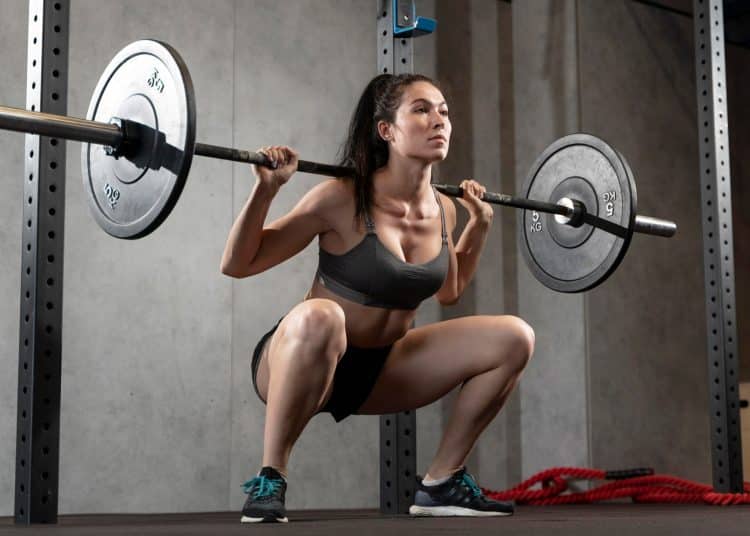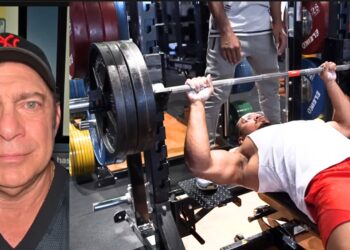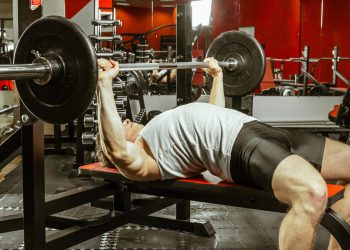Strength training is often portrayed as a complicated, time-consuming way to work out. According to many trainers and fitness influencers, you must do dozens of exercises using a wide range of exotic equipment to build the body of your dreams.
This is not the case!
As a veteran personal trainer with over 30 years of experience, I can categorically tell you that most people can achieve their fitness goals by embracing and mastering just a few basic exercises.
In this article, I reveal the only five barbell exercises you need for a full-body workout. Do these exercises 2-3 times per week for the next few months and see how they transform your body.
Five Barbell Exercises for A Full Body Workout

Whether you want to build muscle, get stronger, tone up, or lose weight, these are the five barbell exercises you need for a full-body workout. Use these movements to train every major muscle in less time.
Level Up Your Fitness: Join our 💪 strong community in Fitness Volt Newsletter. Get daily inspiration, expert-backed workouts, nutrition tips, the latest in strength sports, and the support you need to reach your goals. Subscribe for free!
Re. sets and reps: 3-5 sets per exercise should be enough for most people. Use heavy weights and low reps (3-5) to build strength and moderate to light weights for medium to high reps (6-30) to build muscle (1).
1. Barbell Back Squat
Target Muscles: Quadriceps, hamstrings, gluteus maximus, abductors, adductors, core.
Squats are the crowned king of exercises. Not only do they train your entire lower body, but they’re also incredibly functional and replicate the most strenuous activities of daily living. I tell my clients that a workout is not a workout without squats; if you only ever do one leg exercise, squats should be it. Love them or hate them, you simply must do your squats!
Steps:
- In a squat or power rack, hold a barbell across your upper back so it rests on your traps and not your neck.
- Stand with your feet roughly shoulder width apart and toes turned slightly outward.
- Brace your core, pull your shoulders down and back, and lift your chest.
- Bend your legs, flex your hips, and descend until your thighs are roughly parallel to the floor.
- Drive your feet into the floor and stand back up.
- Reset your core and repeat.
Trainer Tips:
- Do not round your lower back at the bottom of your squat. Doing so increases your risk of back injury.
- Consider wearing a weightlifting belt if squatting heavy loads.
- Add a 3-count pause at the bottom of each rep to make this exercise more challenging without adding extra weight.
Learn more about squats in this in-depth guide.
2. Barbell Romanian Deadlift
Target Muscles: Gluteus maximus, hamstrings, erector spinae, trapezius, forearms.
While back squats are the ultimate lower body exercise, they tend to work your quads more than your glutes and hamstrings. Doing nothing but squats for your legs could result in uneven muscle development. The barbell Romanian deadlift is arguably the best way to develop the muscles that squats can leave untrained.
Steps:
- Stand with your feet between shoulder and hip-width apart. Bend your knees slightly.
- Hold a barbell in front of your thighs using an overhand or mixed grip.
- Pull your shoulders back and down, and brace your core.
- Push your butt backward, flex your hips, and lean forward to lower the barbell down the front of your legs. Descend as far as your flexibility allows.
- Drive your hips forward and stand back up.
- Reset your core and repeat.
Trainer Tips:
- The more you push your hips back, the more you stretch your hamstrings, and the more effective this exercise becomes.
- If you use a mixed grip, make sure you switch your hands around set by set to avoid imbalances.
- Avoid looking at the mirror in front of you when doing this exercise. Lifting your head causes neck hyperextension, leading to neck pain.
Learn more about Romanian deadlift in this in-depth guide.
3. Barbell Bench Press
Target Muscles: Pectoralis major, deltoids, triceps.
If squats are the king of lower body exercises, the bench press holds the same title for your upper body. Working your chest, shoulders, and triceps, the bench press is a hugely popular and effective exercise. Always do bench presses in a power rack or with a spotter on hand; a missed rep can have serious consequences.
Steps:
- Lie on the bench with your eyes directly beneath the barbell.
- Hold the bar with an overhand, slightly wider than shoulder-width grip.
- Pull your shoulders down and back, lift your chest, and push your upper back into the bench.
- Unrack the bar and hold it over your chest.
- Bend your elbows and lower the bar to the high point of your chest. Tuck your elbows in toward your ribs as the bar descends.
- Drive the weight back up, allowing your elbows to flare as the weight ascends.
Tips:
- Lower the bar under control and avoid bouncing the bar off your chest. Doing so increases the risk of injury and takes work away from the target muscles.
- Do not move your feet during your reps, as doing so creates instability and could hurt your bench press performance.
- No bench? No problem! Do barbell floor presses
Learn more about barbell bench press in this in-depth guide.
4. Barbell Pendlay Row
Target Muscles: Latissimus dorsi, deltoids, trapezius, rhomboids, biceps, forearms, core.
The Pendlay row is one of the safest, most effective barbell back exercises around. Starting each rep with the weight resting on the floor means less lower back stress than with conventional barbell rows. That pause also eliminates all momentum, making this a challenging exercise even when you use moderate weights.
Steps:
- Place your barbell on the floor and stand behind it so your toes are underneath.
- Lean forward and hold the bar with an overhand, slightly wider than shoulder-width grip.
- Keeping your arms straight, pull your shoulders down and back, lift your chest, arch your lower back, and set your torso so it’s parallel to the floor.
- Without jerking with your legs or back, smoothly pull the barbell off the floor and into your midsection.
- Lower the weight back down, allow it to settle for 1-2 seconds, reset your core and grip, and repeat.
Tips:
Level Up Your Fitness: Join our 💪 strong community in Fitness Volt Newsletter. Get daily inspiration, expert-backed workouts, nutrition tips, the latest in strength sports, and the support you need to reach your goals. Subscribe for free!
- Pull the bar into your chest to emphasize your upper back or your abdomen to work your lats more.
- Keep your wrists straight to avoid shortening your range of motion.
- Do not allow your lower back to round, as doing so can cause severe injury.
Continue your Pendlay row education with this detailed guide.
5. Barbell Military Press
Target Muscles: Deltoids, triceps, core.
Before the bench press became the world’s favorite upper body exercise, exercisers developed and tested their upper body strength with military presses. In fact, the military press used to be one of the disciplines in Olympic weightlifting. Regardless of its history, the barbell military press is one of the best ways to develop picture-perfect shoulders and arms.
Steps:
- Stand with your feet shoulder-width apart and your knees slightly bent.
- Using an overhand, slightly wider than shoulder-width grip, hold your barbell in front of your clavicles or collar bones. Your forearms should be vertical.
- Lift your chest and pull your shoulders down and back. Brace your core.
- Press the weight up and overhead, pulling your head back to avoid hitting your face.
- Hold the bar overhead with straight but not locked elbows.
- Return to the starting position and repeat.
Tips:
- Do not use your legs to lift the weight. This is called a push-press, which is a different exercise altogether.
- Do the seated military press to isolate your upper body and prevent cheating.
- Take care not to overarch your lower back, as doing so could cause injury.
Related: 15 Best Barbell Exercises for Strength, Size, and Power
Optional Extras
Between them, the five barbell exercises I’ve described above train all your major muscles. However, some people may feel that their arms and core aren’t getting enough work.
Use the following three exercises to plug those gaps – but only if you feel it’s necessary. Remember, your arms and core get plenty of indirect work, so these exercises are optional extras and are not essential for full-body strength.
1. Barbell Biceps Curl
Target Muscles: Biceps, forearms.
Most exercisers have at least a passing interest in the size and strength of their upper arms. Barbell biceps curls are a basic but effective way to add mass to your arms. The supinated or underhand grip ensures your biceps are maximally engaged, and you will get a great workout from this classic old-school exercise.
Steps:
- Stand with your feet shoulder to hip-width apart, knees slightly bent.
- Brace your core, pull your shoulders back and down, and hold your barbell with an underhand shoulder-width grip.
- Without using your legs or back for assistance, bend your arms and curl the weight up to your shoulders.
- Smoothly lower the bar back down until your arms are straight.
- Continue for the prescribed number of reps.
Tips:
- Stand with your back resting against a wall or pillar if you cannot resist cheating during this exercise.
- Use a wide grip to emphasize your inner biceps or a narrow grip to emphasize your outer biceps.
- Pause for 1-2 seconds at the top of each rep to make this exercise more intense and effective.
2. Barbell Skull Crusher
Target Muscles: Triceps.
The barbell skull crusher is so-called because, if you lower the bar too far or too fast, you could end up hitting yourself on the head. Consider this name a reminder to do skull crushers slowly, smoothly, and with an appropriate load!
Steps:
- Lie on a bench and grasp a barbell with a shoulder-width, overhand grip. Hold the bar over your shoulders so your arms are vertical.
- Bend your elbows and carefully lower the bar to your forehead.
- Extend your arms and repeat.
Tips:
- Keep your upper arms vertical to avoid turning this into a pressing exercise.
- Use a spotter if you plan on training close to failure.
- Experiment with different grip widths to see what feels the most comfortable and effective.
3. Barbell Rollouts
Target Muscles: Rectus abdominis, obliques, transverse abdominis, hip flexors, latissimus dorsi.
Your core is active during almost every exercise and movement you perform. It contracts inward to create intra-abdominal pressure and stabilize your spine. As such, you use it like a weightlifting belt whenever you exercise. That said, direct core training will make this muscle group even stronger. Barbell rollouts are one of my favorite core workouts.
Learn more about this fantastic core exercise in this guide.
Steps:
- Place your barbell on the floor and kneel behind it.
- Hold the bar with an overhand, shoulder-width grip.
- Brace your core and pull your shoulders back and down.
- Keeping your arms straight, roll the barbell away from you and lower your body toward the floor.
- Using your abs and lats, pull the bar back toward your legs and return to the starting position.
Tips:
- Reduce your range of motion if you feel this exercise in your lower back.
- Kneel on a foam pad or folded gym mat for comfort.
- Progress to standing rollouts as your core gets stronger.
Closing Thoughts
Strength training does not have to be complicated to be effective. In contrast, the more straightforward your workouts are, the more likely you are to do them.
While there is nothing inherently wrong with more convoluted training programs, if they are impractical or prevent you from working out regularly, they probably aren’t your best option.
Consistency trumps complexity every time!
Build your training around the exercises outlined in this article to achieve great results simply and with less time, equipment, and effort.
Next read: Two-Exercise Workouts for Time-Pressed Bodybuilders
References:
- Lasevicius T, Ugrinowitsch C, Schoenfeld BJ, Roschel H, Tavares LD, De Souza EO, Laurentino G, Tricoli V. Effects of different intensities of resistance training with equated volume load on muscle strength and hypertrophy. Eur J Sport Sci. 2018 Jul;18(6):772-780. doi: 10.1080/17461391.2018.1450898. Epub 2018 Mar 22. PMID: 29564973.








